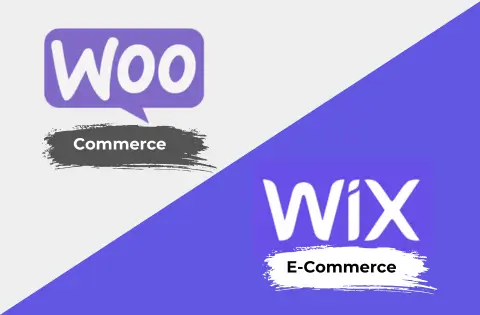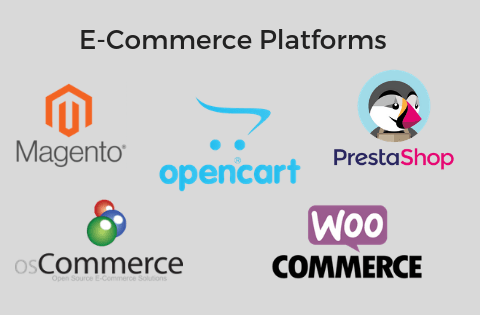WooCommerce Versus Wix eCommerce: Features, Benefits, Cost, Pros & Cons!

As you know eCommerce is experiencing explosive growth there is a pursuit battle between a number of the e-commerce platforms including WooCommerce versus Wix eCommerce.
Today millions of businesses are trying to set up their shops online, to offer a vast array of products and services to a global audience.
Therefore businesses often find it difficult to understand which one platform to choose when there are more than a single option.
The digital marketplace offers incredible opportunities for businesses and entrepreneurs, but navigating the landscape may take time and effort.
Selecting an appropriate platform to build your online shop is one of the most important things to consider at any given time.
And, here’s where two major contenders come in i.e. WooCommerce and Wix eCommerce.
What are WooCommerce and Wix eCommerce?
WooCommerce is similar to other e-commerce solutions such as PrestaShop, Magento, NopCommerce, etc.
However it is not an integrated platform, It is a simple plug-and-play extension that transforms a WordPress website into a fully functional online store.
But, as a WordPress plugin, WooCommerce provides a highly customizable and flexible solution for businesses of all sizes.
It also boasts a vast ecosystem of third-party integrations and robust SEO capabilities.
Wix, on the other hand, is a user-friendly website builder with built-in eCommerce features.
It provides an all-in-one solution, including web hosting, domain name options, and store functionalities for beginners making it more suitable for small businesses or those with simpler needs
Also, Wix eCommerce provides a more managed experience with dedicated customer support and basic SEO features.
But the question is which platform is best for you and this comprehensive guide will equip you to make an informed decision.
Here we will delve into a detailed comparison of the features, benefits, and drawbacks of both WooCommerce and Wix eCommerce.
We’ll also explore factors like store setup, product management, payment processing, marketing, and cost.
So by the end of this article, you’ll be able to choose one platform that best suits your eCommerce vision and propels your online business to succeed.
Feature Comparison: WooCommerce Versus Wix eCommerce
1. Store Setup and Management
WooCommerce and Wix eCommerce setup depends on your technical expertise, customization needs, and scalability requirements.
You may prefer one platform over the other, let dive in.
a) WooCommerce:
WooCommerce offers a hands-on approach to store setup and management.
Your eCommerce journey with WooCommerce begins with installing the WooCommerce plugin on your existing WordPress website.
This involves some functional and technical knowledge, but you may find a lot of resources and tutorials to guide you through.
WordPress’s vast library of free and premium themes allows you to control your online store’s overall look and feel.
You can choose a theme designed for eCommerce or customize a general-purpose theme to match your brand identity.
WooCommerce has an extensive plugin library and that is where this platform excels in its strength.
The plugins add functionalities beyond the core WooCommerce features to scale your store.
For example, you can find plugins for advanced product variations, inventory management, shipping integrations, marketing automation, and more.
Therefore it allows you to tailor your store to your needs and create a unique shopping experience.
b) Wix eCommerce:
Wix prioritizes ease of use, making it ideal for beginners who want to get their online store up and running quickly.
Unlike WooCommerce, the Wix eCommerce platform boasts a collection of pre-designed templates crafted for online stores.
Browse the options, choose a template that aligns with your brand aesthetic, and start customizing!
Using Wix’s drag-and-drop interface makes building your store a breeze.
Also you can arrange elements like product images, descriptions, and call-to-action buttons without needing any coding knowledge.
While less extensive than the WooCommerce plugin library, Wix offers its own App Market.
However these apps can add functionalities like abandoned cart recovery, email marketing tools, and social media integrations to your Wix eCommerce store.
2. Product Management: WooCommerce Versus Wix eCommerce
The comparison highlights the product management features available in both WooCommerce and Wix Ecommerce platforms
a) WooCommerce:
WooCommerce empowers you with a comprehensive suite of product management tools, allowing you to present your offerings in detail.
It will enable you to create detailed product descriptions that capture your customers’ attention.
You can add long descriptions, include images, and embed customer reviews to build trust and encourage sales.
The WooCommerce Product Video plugin is excellent for product videos!
Do you need to offer product variations like size, colour, or material?
If so! WooCommerce allows you to easily configure product variations, ensuring customers can find exactly what they want.
With WooCommerce, you can organize your products into well-defined categories and subcategories.
This makes it easier for customers to browse your store seamlessly and find fast what they need, leading to a more positive shopping experience.
Maintaining accurate inventory levels is paramount.
WooCommerce provides tools to track stock levels, set low-stock notifications, and manage product availability.
This helps you avoid overselling and ensures a smooth shopping experience for your customers.
b) Wix eCommerce:
Wix offers core product management functionalities while prioritizing a user-friendly experience.
Thus, you’ll find that adding products on Wix is straightforward.
But it easily supports physical, digital, and service products
You can upload product images, set prices, and add basic descriptions.
Wix eCommerce is pre-designed to customize the layout of your product pages using the drag-and-drop interface.
You can arrange product images, descriptions, and call-to-action buttons to create a visually appealing product page.
While Wix offers basic product management features, you may face limitations when setting up extensive product variations, managing large inventory quantities, or utilizing advanced tools.
This is simply because Wix offers limited attributes product support and basic inventory management.
3. Payment Processing:
WooCommerce offers greater flexibility and control over payment processing while Wix eCommerce is easier to set up initially with built-in payment processing.
a) Woocommerce Payments:
WooCommerce offers an open and flexible approach to payment processing, allowing you to choose the solution that best suits your needs.
It seamlessly integrates with popular payment gateways like PayPal, Stripe, Authorize.Net, and many more (may require additional plugins).
This allows you to choose a gateway with the best rates, features, and compatibility for your target audience.
You can also get extra features like recurring payments or subscriptions from the vast WooCommerce plugin library.
They allow you to extend your payment processing capabilities.
However, managing multiple plugins can add complexity.
b) Wix Payments:
Wix eCommerce offers built-in options for accepting credit card payments and may integrate with alternative payment solutions.
It also offers its own payment solution called Wix Payments but it has fewer choices compared to WooCommerce
Setting up payment processing is straightforward in Wix eCommerce and doesn’t require any technical expertise.
This eliminates the need for additional setup compared to WooCommerce.
However, transaction fees may be higher (in some cases) than other third-party gateways you could integrate with WooCommerce.
4. Security Compliance: WooCommerce Versus Wix eCommerce
Security is paramount when handling customer financial information, regardless of any e-commerce platform you choose.
The good thing is both WooCommerce and Wix eCommerce offer essential security features:
a) WooCommerce Security Features:
WooCommerce offers greater flexibility but requires more user involvement in security maintenance.
It requires choosing a reputable hosting provider with strong security practices.
SSL Encryption can be implemented through hosting provider or a plugin and PCI Compliance depends on hosting provider and payment gateway used.
Regular Updates are available for both core and plugins but it again requires user responsibility as it is manual.
Data backup for WooCommerce is a manual process hence it also depend on user responsibility
b) Security Wix eCommerce:
Wix provides a more user-friendly experience with automatic updates and managed PCI DSS compliance.
SSL encryption is automatically enabled for all sites.
It also offers built-in DDoS protection and monitors and protects websites against security threats.
Unlike WooCommerce manual backup process, Wix eCommerce platform provides automatic backups and restore points.
Regular updates are managed by Wix, ensuring security patches are applied automatically.
Two factor authentication is also available as a built-in feature for Wix accounts.
Moreover any kind of vulnerability is managed by Wix.
5. Shipping and Fulfillment:
WooCommerce is a more powerful and flexible platform for shipping and fulfillment, while Wix eCommerce is a simpler option.
The best choice for you will depend on your specific needs and budget.
a) WooCommerce:
WooCommerce allows you to configure various shipping methods like flat rate shipping, free shipping above a certain order value, and even real-time shipping quotes based on weight and location (requires additional plugins).
It also offers advanced functionalities like automated shipping rules based on product weight or location.
It also provides integration with specific shipping carriers for discounted rates, and even real-time shipment tracking for your customers.
WooCommerce platform also automatically generates packing slips and Invoices while the order fulfillment process manages picking packing and shipping.
Some various plugins and extensions integrate with WooCommerce to manage order tracking and fulfilment, print shipping labels and do much more.
b) Wix eCommerce:
Wix primarily offers flat-rate shipping (mostly relies on fixed rates) and weight-based shipping (price varies based on product weight).
It also integrates with some popular shipping carriers, but they aren’t as extensive as what is available through WooCommerce plugins.
Moreover, it has limited shipping zone options
Wix eCommerce platform may require additional apps for generating packing slips and invoices and limited order fulfilment features, which may require integration with external services.
One advantage of Wix eCommerce is the built-in order tracking functionality along with the ability to print shipping labels directly from the dashboard.
6. Marketing and SEO: WooCommerce Versus Wix eCommerce
Here are a few comparison outlines for marketing and SEO features available in both WooCommerce and Wix eCommerce platforms
a) WooCommerce:
WordPress boasts a massive library of SEO plugins and offers greater control and flexibility for marketing and SEO.
However, it requires more technical knowledge and setup than Wix eCommerce.
You can use the SEO plugin for optimizing your product pages, meta descriptions, titles, and image alt tags.
This ensures your online store could rank higher in search engine results.
WooCommerce also provides you complete control over your store’s content which means you can blog posts, landing pages, informative articles etc.
This can attract organic traffic. via. SEO optimization and establishing yourself as an authority in your niche.
Thus content marketing strategy can significantly enhance your SEO efforts.
Other features include promotions and discounts, analytics integration, abandon cart recovery, marketing automation, loyalty programs, Ads integration, A/B testing etc.
b) Wix eCommerce:
Wix includes basic SEO tools to optimize your store’s title tags and meta descriptions.
It has built-in marketing tools like email marketing campaigns, social media integration, and abandoned cart recovery.
Thus it allows you to create email campaigns, run social media ads, and connect with your target audience on various platforms.
It also has built-in blogging functionality but has some limitations when it comes to customizing marketing, SEO approaches and app integration.
Benefits of WooCommerce Versus Wix eCommerce
Benefits of Using WooCommerce:
WooCommerce offers greater flexibility, scalability, and control, making it suitable for businesses seeking a customizable and scalable e-commerce solution.
Some of the benefits of using the WooCommerce platform:
- Free and open-source
- Granular control over costs
- Theme flexibility
- Plugin powerhouse
- Scalability for growth
- WordPress Integration
- Vast SEO plugin ecosystem
- Extensive resources and tutorials are available
- Data ownership and control
- Community support
Benefits of Using Wix eCommerce:
Wix eCommerce excels in ease of use, all-in-one convenience, and built-in features, making it ideal for users who prioritize simplicity and convenience.
Let’s look at some of the benefits of using the Wix eCommerce platform:
- Ease-of-use
- Beginner-friendly
- All-in-One Solution
- Drag-and-drop interface
- Wix Artificial Design Intelligence
- Web hosting included
- Domain name options available
- Freemium model
- Multiple paid plans
- App market
- Wix support
Comparing Costs: WooCommerce Versus Wix eCommerce
Besides the pros and cons, we need to compare these two platforms’ costs.
a) WooCommerce:
It’s free and open-source so you can download and use WooCommerce itself at no cost.
Also, free themes and plugins are available to suit your business requirements.
However, additional costs include the domain’s price, web hosting costs, and premium themes and plugins.
You need to purchase a separate web hosting plan to run your store.
You can register a domain name for your business for an annual fee.
Payment processing fees will depend on the payment gateway you choose.
b) Wix eCommerce:
Wix offers various paid plans with increasing features, storage space, and bandwidth.
Freemium plans allow you to try the platform with basic functionalities.
However, they have limitations on features, storage, and branding (Wix ads displayed on your store).
Upgrading to higher plans unlocks more features but increases the costs.
Transaction fees may apply depending on the Wix plan
In essence, WooCommerce offers a lower upfront cost but requires you to manage additional elements like web hosting, themes and plugins.
Wix provides an all-inclusive solution but might have higher transaction fees and limited control over some aspects compared to WooCommerce.
Pros and Cons: WooCommerce Versus Wix eCommerce
Pros and Cons of Using WooCommerce:
Although WooCommerce has many pros, there are some cons to using it. Let’s explore the WooCommerce’s pros and cons now:
Pros of Using WooCommerce:
This eCommerce platform allows you to be your own boss as you get complete ownership of your online store.
WooCommerce can scale with your business as it grows, accommodating larger product catalogues and increased traffic.
There is a vast library of themes and plugins that can fulfil any functionality of your store.
WooCommerce is scalable and it allows your online store to grow alongside your ambitions.
Seamless integration with WordPress allows for easy content and product management.
SEO plugins allow you to boost your search engine rankings.
Moreover, WooCommerce is free to use, making it budget-friendly
Cons of Using WooCommerce:
It requires some technical knowledge to use the platform for beginners.
You need a WordPress website to use WooCommerce, which may not be suitable for all businesses or users.
While the basic WooCommerce plugin is free, costs can accumulate when adding premium extensions or hiring developers for customization.
You have to be Dependent on Third-Party Plugins and the vast plugin library can be overwhelming for beginners, too.
Above all it necessitates ongoing maintenance, requiring constant vigilance for security and performance.
Pros and Cons of Using Wix eCommerce:
Like WooCommerce, Wix eCommerce equally has several pros and cons. Let’s delve into it:
Pros of Using Wix eCommerce:
Wix is very user-friendly and comes with a drag-and-drop system which means you won’t have to code anything.
Also, it is an all-in-one solution which means most of the features are included with a plan.
Essential properties such as web hosting, domain name options, SSL and core eCommerce functionalities are built-in.
It also caters to different budgets, offering free as well as premium.
Another pro is that Wix integrates with popular marketing tools and offers built-in SEO tools.
Cons of Using Wix eCommerce:
There is limited design flexibility even after choosing a template and you can’t switch to a different template later.
Wix eCommerce offers restricted customization and less comprehensive SEO tools.
It has limited app integrations compared to WooCommerce plugins.
Also, the built-in payment processing has higher transaction fees.
Moreover, it has less control over your store’s data ownership and data exports.
Wix may not be the best option for large-scale eCommerce businesses with complex needs.
Conclusion:
The battle between WooCommerce and Wix eCommerce is close to each other excelling in distinct areas.
But the ideal choice hinges on your technical expertise, budget, and long-term vision for your online store.
Therefore for the tech-savvy entrepreneur, WooCommerce is the best choice.
However, beginners will be better off using Wix eCommerce.
The best platform is the one that empowers you to bring your eCommerce vision to life.
So you need to consider your needs carefully and weigh the pros and cons of each platform.
With the right choice, your online store would be poised for success in the ever-evolving world of eCommerce.

